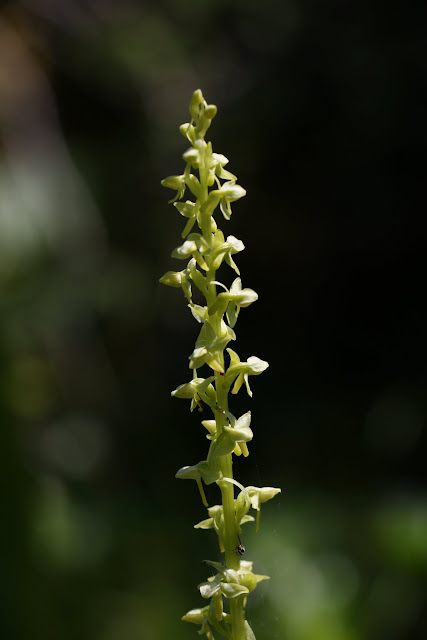A photographic record of the beautiful and often rare native orchids that can be found in our area.
Monday, June 29, 2015
Fifteenth Orchid of the Season
This species is reputed to grow in Washington, in the northern counties east of the Cascades, but it is at the southern limit of its range there and we have not seen it in the state though we continue to look for it. These were photographed in Alaska on a recent vacation trip there. We saw them in several different locations in Kenai Fjords National Park and Denali National Park. The species is small, less than a foot (30 cm) tall with whitish-green flowers. It is easily recognizable by its single leaf at the base of the plant and it's rather oddly shaped flowers, which, though rather inconspicuous, are quite beautiful when observed closely.
Saturday, June 27, 2015
Fourteenth Orchid of the Season
Platanthera stricta, the Slender Bog Orchis, is probably the most common orchid species in the Pacific Northwest and also the least attractive. The plants can be over 100 cm tall with many flowers, but the flowers are small and green. We find it in the ditches along the roads, sometimes in the thousands and very often do not stop to photograph them. These were the first of the season and were photographed along the Spaudling Trail near Juneau. There, too, they were in a wet meadow and seemed to be everywhere. The species is readily identifiable by its long narrow lip and inflated spur, which sometimes looks like a tube with a ball on the end.
Friday, June 26, 2015
Thirteenth Orchid of the Season
One of our ferry stops on the way to Alaska was in Juneau where we were delayed for over eight hours. We used the time to hike the Spaulding trail and the Auke Nu trail just south of the ferry terminal and found two native orchids along the trail, the Green Bog Orchis, Platanthera huronensis, featured in another post, and the Tall White Northern Bog Orchis, Platanthera dilatata var. dilatata. The latter species grows all over the Pacific Northwest but is always a treat to see. It is also strongly scented and is a delight for that reason also. There are three varieties of this species distinguished by the length of the spur. This variety has a spur that equals the length of the lip. This was our first sighting of the species but we expect to see many more of them before the summer is over and hope to see the other varieties as well.
Friday, June 5, 2015
Twelfth Orchid of the Season
We made a brief stop recently in north-central Washington to see a patch of the Columbia Hybrid Lady's Slippers, Cypripedium x columbianum, a natural hybrid of the Mountain Lady's Slipper, Cypripedium montanum and the Yellow Lady's Slipper, Cypripedium parviflorum var. pubescens. In this hybrid population, which grows mixed together, there are flowers that look like both parents, with either a yellow or white lip, as well as flowers that are clearly intermediate between the parents, the lips a soft yellow or off-white color. When we visited this patch, it was obvious that it had not been a very good year with fewer than normal plants and we also found most of them finished, though we did take enough photos for a blog post.
Cypripedium x columbianum
Eleventh Orchid of the Season and Others
The orchid featured in this post is not a separate species, but an unusual and unique variety of a species I've previous posted and so I am counting it as our eleventh orchid of the season. It is a variety of the Western Spotted Coralroot known as the Ozette Coralroot, Corallorhiza maculata var. ozettensis. There are several sites on Whidbey Island where it can be found but it was originally discovered on the Olympic Peninsula. It is unique both for its coloring and its lack of spotting.
Corallorhiza maculata var. ozettensis
Along with it we found the Spotted Coralroot, Corallorhiza maculata var. maculata, near the end of its bloom season. This variety is found across the United States and Canada, while the other two varieties are found only in the west. Among the Spotted Coralroots we found, as we had previously, some spikes of a plant that has the coloration of the Ozette Coralroot, but also has spotting. The coloration and the fact that these bloom with the Ozettes make me this it is a hybrid of the Ozette and the Spotted.
Corallorhiza maculata var. maculata
a possible hybrid of var. ozettensis and var. maculata
A couple of other observations and this first: all three varieties of the Spotted Coralroot grow in the same area, sometime among each other, but the bloom times are clearly successive, the Western Spotted Coralroot blooming first, the Spotted Coralroot after it, and the Ozette Coralroot as the Spotted are finishing their blooms. These different bloom times are the principle reason for separating these varieties and the easiest way to distinguish them when they are growing in the same location.
Also, we have noticed that the native orchids and especially the Coralroots are very sparse this year at lower elevations, especially near sea level. This may be due to a very warm winter with little snowfall and an early and warm spring. What is especially striking, however, is that at higher elevations the native orchids appear to be more abundant, something a friend has also ascribed to the warm winter. She believes that the warmer temperatures in the mountains have promoted the growth of the mycorhyzal fungus on which these orchids depend.
Subscribe to:
Posts (Atom)































































